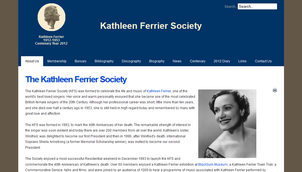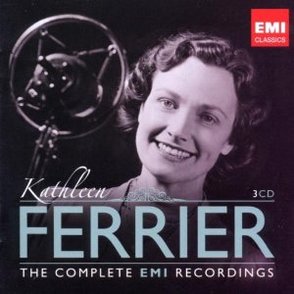|
Kathleen Ferrier was (and still is) one of the world’s great singers. Her appeal transcends all ages and seemingly all generations, more so perhaps than any other singer. She died more than fifty years ago, yet she is still remembered and her voice is still heard and loved by millions around the world.
Kathleen Mary Ferrier was born on 22 April 1912 at Higher Walton, a village near Preston in Lancashire in the North of England. She died in London on 8 October 1953. During her short career she went from one triumph to another, received the adulation of her peers, of critics and of audiences all over the world and still maintained her natural charm, nobility, humility, humour and love for truth, people and life. Kathleen’s father was the village schoolmaster at Higher Walton. A good singer himself, he taught most of the music at the school. He later became a headmaster in Blackburn and the family moved there when Kathleen was two years old. Kathleen did not begin her career as a singer. She was a keen member of the school choir but even then she had a big voice and she was usually asked just to stand at the back and sing quietly. Her mother, keen to encourage Kathleen’s musical interest, arranged piano lessons for her and, as a talented young pianist of only 14 she passed the final grade of the Associated Board of the Royal Academy of Music and the Royal College of Music. A newspaper of the time called this ‘an unprecedented success for so youthful a student.’ Kathleen left school at 14 and went to work for the GPO in Blackburn, first in the telegrams department and then as a switchboard operator. In July 1930, at the age of 18, Kathleen took part in her first concert as a pianist, which was broadcast from Manchester, and began to accompany many local singers in a musical scene which was very active in Lancashire. She regularly entered and won all the major music festivals, but had become interesting in singing and began taking some rudimentary lessons from the singers she accompanied. By the time Kathleen was 23 she was married and living in Silloth, on the Cumbrian coast, where her husband was the local bank manager. Kathleen gave piano lessons to the local children. When she entered the prestigious Carlisle Festival in 1937 as a pianist, her husband bet her a shilling that she dare not enter for the singing contest as well as the piano prize. Never one to refuse a dare Kathleen accepted the challenge, entered the contralto solo class and not only carried off both trophies, but won the first prize for the best singer at the Festival. Carlisle was a turning point, and this brilliant new singer was in great demand. In 1939 she made her first radio broadcast as a singer. Kathleen was approached by CEMA – the Council for the Encouragement of Music and the Arts, and the forerunner of the Arts Council of Great Britain. It was now wartime and CEMA were doing an ENSA style job in bringing music to people in the factories, villages and hostels throughout Britain, during the war years. In June 1941 she signed up with CEMA and her professional career had effectively begun. The CEMA tours were hard but invaluable and important training for Kathleen. Wartime travel was extremely difficult and the venues were geographically haphazard, the North one day, South next, North the day after, and so on. She sang in church halls, cinemas, schools and factories – in fact anywhere where an audience could be got together. In 1942 Kathleen sang for the great English conductor Sir Malcolm Sargent who told her that she had a great future, but that to further her career she must live in London. With the help of her sister, Winifred, the decision was made and they moved into a flat in Hampstead. Kathleen began lessons with the baritone singer Professor Roy Henderson who helped to improve Kathleen’s voice dramatically. Kathleen’s career began to take off. She made records and became well known on the concert platform and in all the great oratorio works, particularly the Messiah and Elgar's masterpiece The Dream of Gerontius. The composer Benjamin Britten wrote his second opera, The Rape of Lucretia, with Kathleen in mind for the title role. Kathleen sang for the first time in New York in 1948, to great acclaim, and then began tours of America, Canada, Holland, Scandinavia and America again. The problems of travelling abroad were almost as bad as travelling at home. Stars in those days did not have the entourages they have now, and Kathleen was mostly on her own, coping with indifferent and sometimes non-existent hotel arrangements. During 1951 Kathleen had an operation to remove a malignant breast tumour. This seemed to be successful and she resumed her career after a spell in hospital. She toured again, at home and abroad and was one half of many brilliant collaborations – with Roy Henderson, Benjamin Britten, Sir John Barbirolli and the great German conductor Bruno Walter, with whom she was instrumental in bringing the work of the composer Gustav Mahler to a much wider audience. Throughout 1952 she was dogged by problems of movement and it was found that further treatment was necessary. Determined as ever, she fulfilled as many of her commitments as she could between regular hospital visits. Eventually though, she was unable to meet the travel demands. She and Barbirolli were working on an English version of Orfeo and it was as much as she could do to keep up with this. Despite a further operation her condition continued to deteriorate and she was re-admitted to hospital where she died on 8 October 1953. Kathleen Ferrier’s life was not a tragic one, even despite its brevity. She was forty-one years old when she died. In the ten years or so of fame which were granted her she achieved more than most singers achieve in a lifetime. In tribute Bruno Walter said that the greatest privileges in his life were to have known and worked with Kathleen Ferrier and Gustav Mahler – in that order. © The Kathleen Ferrier Society |
Articles, Websites & ResourcesDiscographyYouTube & Multimedia |

